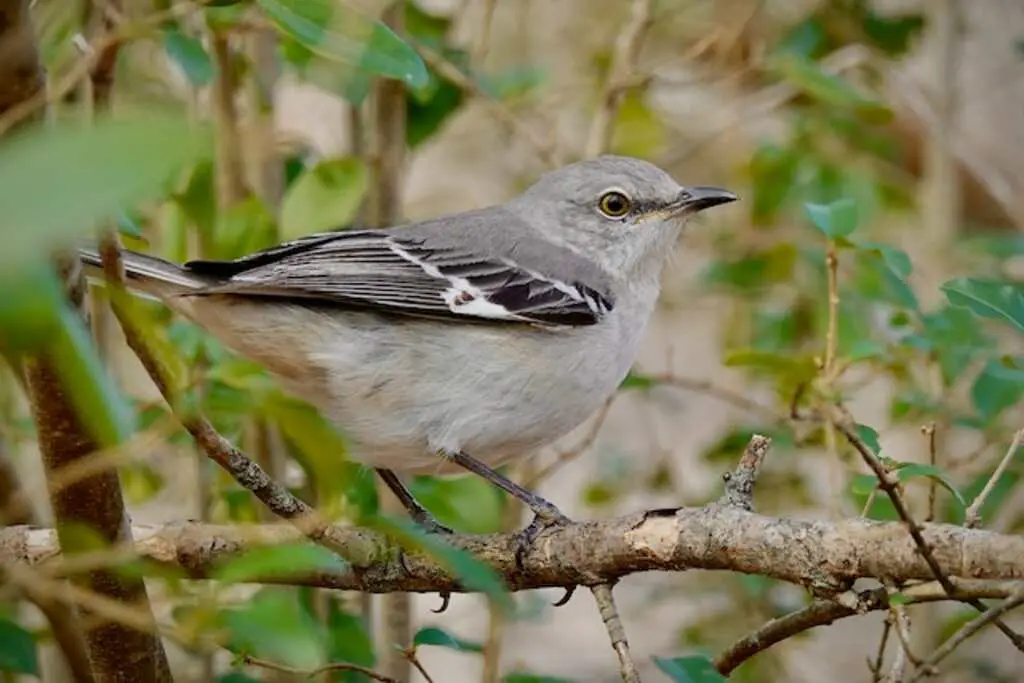Are you ready to meet the Lone Star State’s most beloved avian resident? Drumroll, please… Meet the Texas State Bird: the Northern Mockingbird! This charming bird with a talent for mimicry has captured the hearts of Texans for generations.
From its fascinating habits to its unique place in Texas history, this article will give you all the scoop on why the Northern Mockingbird reigns supreme in the Lone Star State. Get ready to chirp with excitement!
Table of Contents
- 1 History of the Texas State Bird: Northern Mockingbird
- 2 Overview of the Northern Mockingbird
- 3 Symbolic Representation of the Northern Mockingbird for Texans
- 4 Appearance of the Texas State Bird
- 5 Behavior and Feeding Habits of the Northern Mockingbird
- 6 Interesting Facts About the Texas State Bird
- 7 Conservation Status and Threats to the Texas State Bird
- 8 How to Attract Northern Mockingbirds to Your Yard
- 8.1 Creating a suitable habitat with shelter, water, and food sources
- 8.2 Planting native trees and shrubs to provide nesting sites and food
- 8.3 Offering supplemental food sources, such as mealworms and fruit
- 8.4 Providing nesting boxes or platforms
- 8.5 Tips for observing and enjoying Northern Mockingbirds while minimizing disturbance
- 9 FAQs About The Texas State Bird: Northern Mockingbird
- 9.1 What is the difference between a Northern Mockingbird and a mockingbird?
- 9.2 Can Northern Mockingbirds imitate sounds other than birdsong?
- 9.3 Do Northern Mockingbirds migrate, or do they stay in Texas year-round?
- 9.4 Are Northern Mockingbirds protected by law, and can they be kept as pets?
- 9.5 How can I tell if a Northern Mockingbird is male or female?
- 10 Conclusion
- 11 Author
History of the Texas State Bird: Northern Mockingbird
Origin of the selection of the state bird
In 1927, the Texas Federation of Women’s Clubs requested that the Northern Mockingbird be designated as the official state bird of Texas. The request was made to the Texas Legislature, and after some debate, the bill was passed and signed into law by Governor Dan Moody.
Key individuals involved in the selection process
The Texas Federation of Women’s Clubs played a significant role in the selection of the Northern Mockingbird as the state bird of Texas. The organization was founded in 1897 and was dedicated to promoting education, civic responsibility, and social welfare.
The group recognized the Northern Mockingbird as a symbol of the state’s unique character and felt that it was a fitting representative of Texas.
Other state bird contenders
Before the Northern Mockingbird was selected, several other birds were considered for the position of state bird. The Blue Jay, the Cardinal, and the Robin were all popular choices, but ultimately, the Northern Mockingbird was chosen for its unique qualities.
| Bird | Reason for Consideration |
|---|---|
| Blue Jay | Colorful and common in Texas |
| Cardinal | Colorful and common in Texas |
| Robin | Common in Texas and known for its beautiful song |
Overall, the Northern Mockingbird was chosen as the state bird of Texas for its unique vocal abilities, its fierce protection of its nest, and its representation of the state’s unique character.
Today, the Northern Mockingbird remains a beloved symbol of Texas and is cherished for its beautiful song and its role in the state’s history.
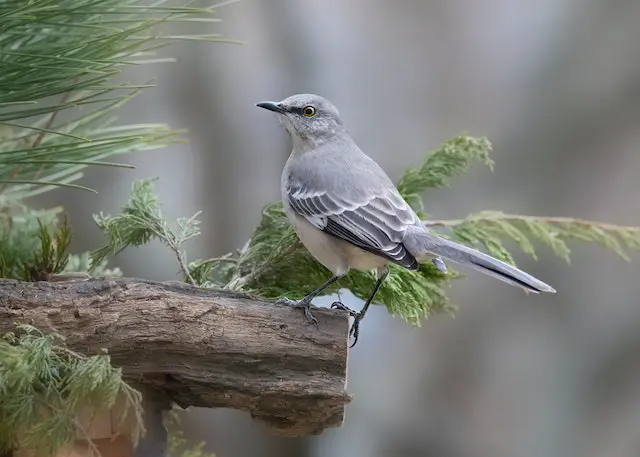
Overview of the Northern Mockingbird
If you’re in Texas, you’ve probably heard the beautiful and melodic sounds of the Northern Mockingbird. The state bird of Texas is a medium-sized bird with long legs and tail that is known for its beautiful songs and ability to mimic other bird calls.
Description of the Northern Mockingbird
The Northern Mockingbird is a grayish-brown bird with white patches on its wings and a long tail. It has a slender, curved beak and a black patch on its face. The bird is about 9-11 inches long and weighs around 1.5-2 ounces.
Habitat and Range
The Northern Mockingbird is found throughout North America, from southern Canada to Mexico. They can also be found in Hawaii, where they have been introduced and established. In Texas, they can be found in a variety of habitats, including urban areas, parks, and open woodlands.
Behavior and Vocalizations
The Northern Mockingbird is known for its beautiful songs and its ability to mimic other bird calls. These birds have the ability to sing a repertoire of up to 200 songs, which may include the melodies of other avian species, insect and amphibian vocalizations, and even sporadic mechanical noises.
They are also known for their aggressive behavior, especially during breeding season, when they will defend their territory fiercely.
Feeding Habits
The Northern Mockingbird consumes a diverse range of food, including insects, fruits, and berries. They are also known to eat small lizards and other small animals. They will often forage on the ground or in shrubs and trees.
| Scientific Name | Mimus polyglottos |
|---|---|
| Length | 9-11 inches |
| Weight | 1.5-2 ounces |
| Habitat | Open woodlands, urban areas, parks |
| Range | North America, from southern Canada to Mexico |
| Diet | Insects, fruits, berries, small animals |
Symbolic Representation of the Northern Mockingbird for Texans
The Northern Mockingbird is not just any bird for Texans. It is the state bird of Texas and holds a special place in the hearts of Texans. Here are some reasons why:
Cultural significance of the bird in Texas
The Northern Mockingbird is a beloved bird in Texas. It has been featured in songs, books, and other forms of art. The bird’s beautiful singing voice is one of the reasons why it is so popular. In fact, the Northern Mockingbird is known for its ability to imitate the songs of other birds, making it a true musical artist.
Texans have also adopted the Northern Mockingbird as a symbol of their state’s rich cultural heritage. The bird’s resilience and adaptability are qualities that Texans admire and strive to emulate.
How the bird represents the state’s values and identity
The Northern Mockingbird is a fitting symbol for the state of Texas. Like Texans, the bird is tough, independent, and resourceful. It is also fiercely loyal to its territory and will defend it against all comers.
The bird’s adaptability is another quality that resonates with Texans. In a state that has seen its share of challenges and changes over the years, the ability to adapt and thrive is a valuable trait.
| Symbolic Representation of the Northern Mockingbird for Texans | Description |
|---|---|
| Cultural significance of the bird in Texas | The Northern Mockingbird is a beloved bird in Texas. It has been featured in songs, books, and other forms of art. |
| How the bird represents the state’s values and identity | The Northern Mockingbird is a fitting symbol for the state of Texas. Like Texans, the bird is tough, independent, and resourceful. |
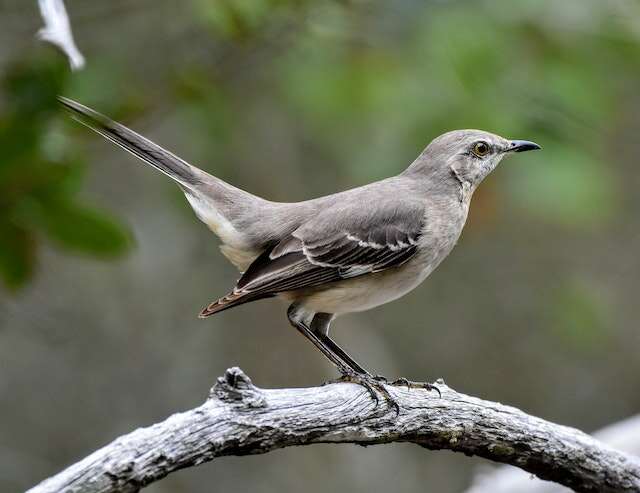
Appearance of the Texas State Bird
As you explore the Northern Mockingbird, it’s important to understand its physical characteristics. This bird has a slender body with a long tail and wingspan that ranges from 12 to 15 inches. The Northern Mockingbird measures eight to 11 inches from head to tail.
Physical characteristics of the Northern Mockingbird
The Northern Mockingbird has grayish-brown feathers on its back and wings, with a white or light-gray belly. Its black bill features a brown shade at the base. The bird’s eyes are black and its legs and feet are pinkish-brown.
| Physical Characteristics | Description |
|---|---|
| Feathers | Grayish-brown on back and wings, white or light-gray on belly |
| Bill | Black with brown shade at base |
| Eyes | Black |
| Legs and feet | Pinkish-brown |
Sexual dimorphism
Male and female Northern Mockingbirds have similar physical characteristics, making it difficult to distinguish between the sexes. One commonly observed difference between males and females is that males tend to have a slightly larger body size than females.
Overall, the Northern Mockingbird is a sleek and elegant bird with unique physical characteristics that make it easy to identify.
Its grayish-brown feathers, black bill, and pinkish-brown legs and feet are just a few of the features that make this bird stand out.
Behavior and Feeding Habits of the Northern Mockingbird
The Northern Mockingbird is a fascinating bird with unique behaviors and feeding habits. In this section, we will explore its territorial behavior, nesting and breeding habits, diet and feeding preferences, and more.
Territorial behavior
The Northern Mockingbird is known for its territorial behavior, especially during the breeding season. Males will defend their territory aggressively against other males and even other bird species. They will chase and attack intruders, and their songs become louder and more frequent when defending their territory.
Nesting and breeding habits
The Northern Mockingbird is a monogamous bird and will mate with the same partner for several breeding seasons. They build their nests in shrubs, trees, or vines, usually between 3 and 10 feet off the ground.
The female lays 2-6 eggs, which she incubates for about 12-13 days. Both parents will feed and care for the chicks until they fledge, which usually takes about 12-13 days.
Diet and feeding preferences
The Northern Mockingbird has a varied diet, which includes insects, fruits, berries, and seeds. They are also known to eat small lizards and other small animals. They forage on the ground, in bushes, and on trees, and they are opportunistic feeders. They will eat what is available and what they can catch.
Here is a table that summarizes the Northern Mockingbird’s diet and feeding preferences:
| Food | Percentage of Diet |
|---|---|
| Insects | 50% |
| Fruits and berries | 25% |
| Seeds | 15% |
| Other small animals | 10% |
The Northern Mockingbird is a fascinating bird with unique behaviors and feeding habits. Understanding its behavior and feeding preferences can help us appreciate and protect this important species.

Interesting Facts About the Texas State Bird
If you’re a Texan or a bird lover, you probably know that the Northern mockingbird is the official state bird of Texas. But did you know that this bird has some interesting facts that make it unique and fascinating? Here are some fun facts about the Texas state bird:
Captivity Survival
The Northern mockingbird has a maximum lifespan of eight years in the wild, but in captivity, they can live up to 20 years. This is because they are protected from predators and have access to a consistent food source.
Singing Ability
The Northern mockingbird is known for its extraordinary vocal abilities. These birds have a repertoire of around 200 songs, which encompasses not only their own melodies but also the vocalizations of other avian species, insect and amphibian calls, and even artificial sounds. They use their songs to communicate, attract mates, and defend their territory.
Monogamy
The Northern mockingbird is a monogamous bird, meaning that they mate for life. They are loyal to their partners and will defend their nests and territory together.
Population Status
The Northern mockingbird population is stable, and they are not considered endangered. However, they are protected by the Migratory Bird Treaty Act, which makes it illegal to harm or kill them without a permit.
Flight Abilities
The Northern mockingbird is an agile and fast flyer. They can fly up to 31 miles per hour and have the ability to hover in midair to catch insects.
Intelligence
The Northern mockingbird is a highly intelligent bird. It has been documented that they use tools, such as twigs, to extract insects from cracks and crevices. They are also able to recognize individual humans and respond differently to them based on their past experiences.
Entertainment Inspiration
The Northern mockingbird has been an inspiration for many artists and writers. It has been featured in literature, music, and art as a symbol of Texas and its unique culture.
Presence as a Native Species
The Northern mockingbird is a native species to Texas and is found throughout the state. These birds have a preference for open environments like parks, gardens, and suburban areas.
Threats from Illegal Trade
Although the Northern mockingbird is not currently threatened, it has been illegally traded in the past for its singing ability. This illegal trade can harm wild populations and disrupt the ecosystem.
Unique White Blotches
The Northern mockingbird has unique white blotches on its wings that are visible when it is in flight. These blotches are thought to be a form of communication, as they are used to signal other birds during territorial disputes.
Behavioral Development
The Northern mockingbird has a unique behavioral development process. They learn their songs during a critical period in their development, and they will continue to add new songs to their repertoire throughout their lives.
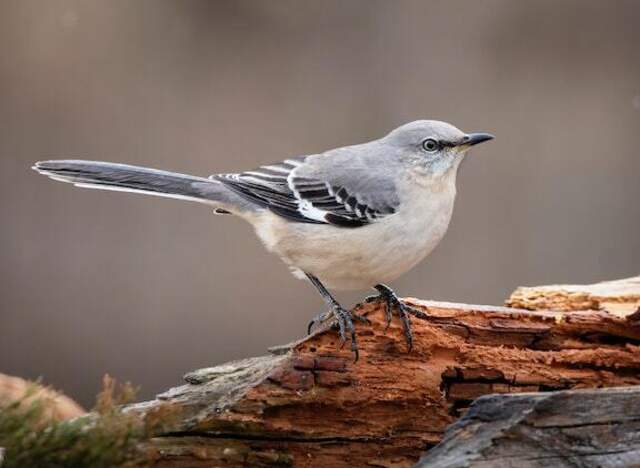
Conservation Status and Threats to the Texas State Bird
Population Trends and Distribution
The Northern Mockingbird is a common bird species in Texas and across North America. According to the Texas Parks and Wildlife Department, the Northern Mockingbird is a species of “Least Concern” in Texas. However, it is important to monitor the population trends and distribution of this species to ensure its continued survival.
Threats from Habitat Loss and Climate Change
Habitat loss and climate change are two major threats facing the Northern Mockingbird in Texas. The loss of natural habitats due to urbanization and agriculture can reduce the availability of food and nesting sites for the bird. Climate change can also impact the bird’s habitat and food sources. As temperatures increase, the timing of the seasons can shift, which can affect the timing of migration and breeding for the bird.
Conservation Efforts
Several conservation efforts are underway to protect the Northern Mockingbird in Texas. The Texas Parks and Wildlife Department has identified the Northern Mockingbird as a species of “Greatest Conservation Need” and is working to conserve its habitat and monitor its population.
The American Bird Conservancy also promotes the conservation of the Northern Mockingbird and its habitat. Additionally, individuals can contribute to the conservation of the Northern Mockingbird by supporting bird-friendly practices, such as planting native plants and reducing pesticide use.
Overall, it is important to continue monitoring the population trends and distribution of the Northern Mockingbird in Texas and to address the threats facing the bird to ensure its continued survival.
How to Attract Northern Mockingbirds to Your Yard
Creating a suitable habitat with shelter, water, and food sources
To attract Northern Mockingbirds to your yard, you need to create a suitable habitat that meets their basic needs. Mockingbirds need shelter, water, and food sources to survive and thrive. Provide shelter by planting native trees and shrubs that offer good nesting sites and cover from predators.
Mockingbirds prefer dense, thorny shrubs and trees such as Eastern Red Cedar, Red Mulberry, and Wild Blackberry. Water is essential for mockingbirds, so make sure to provide a clean source of water such as a birdbath or fountain.
Ensure that the water is kept fresh and clean by regularly changing it. Mockingbirds are omnivores, so they eat a variety of foods such as insects, fruit, and seeds.
Planting native trees and shrubs that produce berries such as American Beautyberry, Elderberry, and Pokeweed can attract mockingbirds to your yard.
Planting native trees and shrubs to provide nesting sites and food
Planting native trees and shrubs is a great way to attract Northern Mockingbirds to your yard. Native plants provide natural food sources and nesting sites for mockingbirds.
Choose plants that produce berries, fruits, and seeds, such as Red Mulberry, Black Cherry, and Eastern Red Cedar. These plants also provide nesting sites and cover for mockingbirds.
Offering supplemental food sources, such as mealworms and fruit
Supplemental food sources such as mealworms and fruit can also attract Northern Mockingbirds to your yard. Offer mealworms in a shallow dish or feeder, and provide halved oranges or raisins on a platform feeder.
Providing nesting boxes or platforms
Mockingbirds prefer to nest in dense shrubs and trees, but they will also use nesting boxes or platforms. Provide a nesting box or platform in a quiet, secluded area of your yard, and make sure it is at least six feet off the ground.
Tips for observing and enjoying Northern Mockingbirds while minimizing disturbance
Observing and enjoying Northern Mockingbirds can be a fun and rewarding experience. To minimize disturbance, keep a safe distance and avoid making sudden movements or loud noises. Use binoculars or a spotting scope to get a closer view.
Mockingbirds are known for their beautiful and complex songs, so take some time to listen and appreciate their musical talents. Be sure to demonstrate respect for wild animals and their environments to preserve their natural habitats
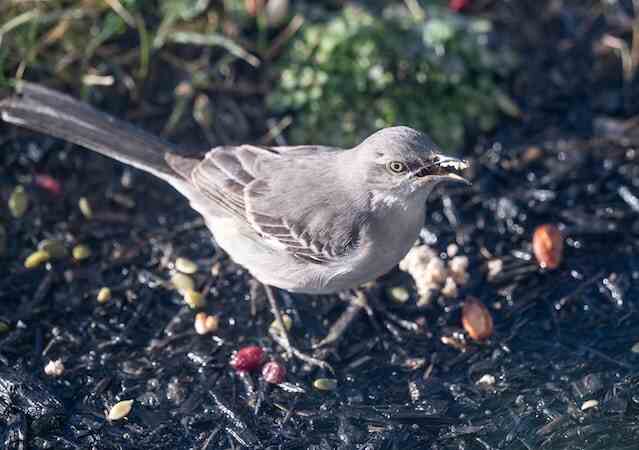
FAQs About The Texas State Bird: Northern Mockingbird
What is the difference between a Northern Mockingbird and a mockingbird?
While the Northern Mockingbird is a type of mockingbird, there are some differences between the two. Northern Mockingbirds are larger than other types of mockingbirds, and they also have longer tails. Additionally, Northern Mockingbirds have a more varied song repertoire and are more aggressive in defending their territory.
Can Northern Mockingbirds imitate sounds other than birdsong?
Yes, Northern Mockingbirds are known for their ability to imitate sounds other than birdsong. They can mimic the sounds of other animals, such as frogs and insects, as well as human-made sounds like car alarms and cell phone ringtones.
Do Northern Mockingbirds migrate, or do they stay in Texas year-round?
While some Northern Mockingbirds do migrate, many stay in Texas year-round. They are well-adapted to the state’s climate and can survive the hot summers and mild winters.
Are Northern Mockingbirds protected by law, and can they be kept as pets?
Yes, Northern Mockingbirds are protected under the Migratory Bird Treaty Act, which makes it illegal to harm or capture them without a permit. They also cannot be kept as pets, as it is against the law to keep native North American birds as pets without a special permit.
How can I tell if a Northern Mockingbird is male or female?
It can be difficult to tell the difference between male and female Northern Mockingbirds, as they look very similar. However, males are slightly larger than females and may have a slightly longer tail. Additionally, male Northern Mockingbirds may sing more frequently and loudly than females.
Conclusion
And there you have it – the Northern Mockingbird, the beloved Texas State Bird! We’ve covered everything from its physical traits to its cultural significance, and it’s clear that this bird is a true Texan icon.
Whether you’re a bird lover or just someone with an appreciation for the natural world, the Northern Mockingbird is a must-see on your travels through Texas.
So next time you’re out and about, keep an ear out for the sweet songs of the state bird and take a moment to appreciate its unique charm. Happy birdwatching!
Related Post:

